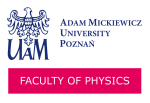FluMag: Fluxons and Magnons in hybrid nanostuctures
Tile of the project
Low-loss current- and flux quanta-controlled magnonics
Call, grant No
OPUS22+LAP, National Science Center – Poland, 2021/43/I/ST3/00550

Start date, end date
January 2, 2023 — January 1, 2026
Budget
1 042 994,00 PLN (for Polish side)
Abstract
Magnonics – the study of spin waves, which are precessional excitations of spins in magnetic materials – is one of the most rapidly developing research fields of modern magnetism. Covering a wide frequency range from sub-GHz to tens of THz and being free from the translational motion of electrons and Joule heating, spin waves are promising candidates for realizing novel, highly efficient wave-based computing concepts. While magnonics has traditionally been a room-temperature research discipline, the current great interest in hybrid systems for quantum computing requires the operation magnonic conduits at low temperatures and in environments of superconducting circuits. In this project, we are going to extend the functionalities of magnonic devices by controlling them with stray fields of superconductors.
Ferromagnetism (F) and superconductivity (S) belong to the most fundamental phenomena in condensed matter physics. Due to incompatible spin orders and antagonistic responses to an external magnetic field, their combination gives rise to numerous novel phenomena. However, the coexistence of F and S in bulk systems remains a rare circumstance peculiar to complex compounds. At the same time, the coexistence of S and F can be readily achieved in artificial ferromagnet/superconductor (F/S) heterostructures. In this regard, F/S hybrid structures can be classified either as proximity-coupled (i.e., electrically connected) or as stray-field-coupled (i.e., electrically insulated).
The project FulMag is formulated to scrutinize the physics of spin waves in electrically insulated F/S heterostructures where the interplay of spin-wave dynamics in a ferromagnet with stray fields produced by eddy currents in a superconductor can be used to explore novel magnonic functionalities in the emerging domain of cryogenic magnonics.
We will conceive theoretical foundations of the spin-wave dynamics in F/S hybrid structures and elaborate novel concepts for the excitation, manipulation, and detection of spin waves, which are beyond the reach of traditional magnonic approaches. The focus will be pointed towards cryogenic magnonic nano-devices operating preferably in the short-wavelength (exchange) spin-wave regime. Their realization will be underpinned by the fundamental physical phenomena of Meissner screening and the Cherenkov radiation of magnons originating from moving magnetic flux quanta (Abrikosov vortices). A complete and multidisciplinary theoretical description, encompassing finite-element micromagnetic simulations in conjunction with the state-of-the-art phenomenological models relying upon the Landau-Lifschitz-Gilbert equation for dipole-exchange spin-waves and the London equations or Ginzburg-Landau model of superconductivity, will allow us to design F/S hybrids with targeted functionalities. We are going to use the stray field generated by the superconducting pattern to confine and guide the spin waves in a homogeneous ferromagnetic layer. We are planning to investigate spin-wave couplers realizing the non-reciprocal spin-wave transmission/reflection and graded-index structures controlling the spin-wave refraction. Device prototypes will be examined at microwave frequencies up to 70 GHz, vector magnetic fields up to 9 T, temperatures down to 10 mK, and by time- and spatially-resolved optical spectroscopy methods. The project results will have a great impact on the domains of microwave magnetism, superconductivity, and emerging magnon-based quantum technologies.
The three Partner Teams of researchers gathered around this Polish-Austrian-Czech collaborative project constitute a rich panel of complementary expertise in theoretical and experimental physics of spin waves, superconductivity, advanced nanofabrication as well as microwave and optical spectroscopy methods. The Polish Team is led by Jarosław Kłos from the Adam Mickiewicz University, Poznań (>>>), the Austrian Team is by Oleksandr Dobrovolskiy from the University of Vienna (>>>) and the Czech Team by Michal Urbanek from the Central European Institute of Technology, Brno (>>>).

Research tasks
- Theoretical studies of spin wave in ferromagnet/Meissner-state-superconductor hybrids
- Theoretical models for Landau-Lifshitz-Gilbert equation coupled to London equations
- Investigations of coupled spin wave and vortex dynamics
- Measurements and calculations of spin-wave dispersions in ferromagnet/superconductor heterostructures
- Development of ferromagnet/superconductor conduits for spin-wave steering and routing – directional couplers.
- Development of ferromagnet/superconductor conduits for spin-wave steering and routing – Graded-index structures
- Utilization of static arrays of superconducting vortices for spin-wave excitation/detection
- Generation of spin waves by moving fluxons
- Phase-locked detection of spin waves by a moving lattice of fluxons with ac-shaken vortices
[1] I.A. Golovchanskiy, N.N. Abramov, V.S. Stolyarov, A.A. Golubov, V. V Ryazanov, and A. V Ustinov, Nonlinear spin waves in ferromagnetic/superconductor hybrids, J. Appl. Phys.127 (2020) 93903. doi:10.1063/1.5141793.
[2] K.-R. Jeon, C. Ciccarelli, A.J. Ferguson, H. Kurebayashi, L.F. Cohen, X. Montiel, M. Eschrig, J.W.A. Robinson, and M.G. Blamire, Enhanced spin pumping into superconductors provides evidence for superconducting pure spin currents, Nat. Mater. 17 (2018) 499–503. doi:10.1038/s41563-018-0058-9.
[3] I.A. Golovchanskiy, N.N. Abramov, V.S. Stolyarov, V. V Bolginov, V. V Ryazanov, A.A. Golubov, and A. V Ustinov, Ferromagnet/Superconductor Hybridization for Magnonic Applications, Adv. Func. Mater. 28 (2018) 1802375. doi:10.1002/adfm.201802375.
[4] O. V Dobrovolskiy, R. Sachser, T. Brächer, T. Böttcher, V. V Kruglyak, R. V Vovk, V.A. Shklovskij, M. Huth, B. Hillebrands, and A. V Chumak, Magnon-Fluxon Interaction in a Ferromagnet/Superconductor Heterostructure, Nat. Phys. 15 (2019) 477. doi:10.1038/s41567-019-0428-5.
[5] A. Shekhter, L.N. Bulaevskii, and C.D. Batista, Vortex Viscosity in Magnetic Superconductors Due to Radiation of Spin Waves, Phys. Rev. Lett.106 (2011) 37001. doi:10.1103/PhysRevLett.106.037001.

